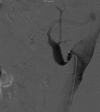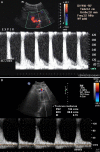A patient presenting with stress-induced epigastric pain
- PMID: 25678616
- PMCID: PMC4330420
- DOI: 10.1136/bcr-2014-207799
A patient presenting with stress-induced epigastric pain
Abstract
The median arcuate ligament passes the truncus coeliacus superior to its ostium. If it is thickened and located too low, it can cause external compression and stenosis of the truncus coeliacus, leading to postprandial abdominal pain and vomiting. This combination of symptoms is called median arcuate ligament syndrome. We report the case of a 79-year-old patient who suffered from chronic epigastric pain, which was initially assumed to be caused by either coronary artery disease or atherosclerotic stenosis of the coeliac artery. Angiography excluded coronary artery disease, but showed severe external stenosis of the truncus. The patient underwent laparoscopic release of the median arcuate ligament, which resulted in relief of his symptoms. The median arcuate ligament syndrome should be considered in patients with epigastric stress-induced pain. Further underlying pathologies, especially coronary artery disease, as life-threatening diagnosis have to be initially excluded.
2015 BMJ Publishing Group Ltd.
Figures


References
Publication types
MeSH terms
LinkOut - more resources
Full Text Sources
Other Literature Sources
Medical
